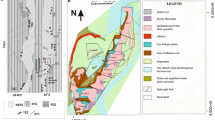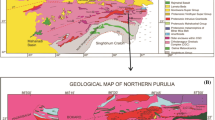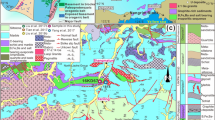Abstract
The Malanjkhand granodiorite (MG) hosting economic copper mineralization and the hitherto barren Dongargarh granitoids (DG) have subtle differences in their petrographic and bulk geochemical features. The two plutons are contiguous and occur in the northern part of the Bhandara Craton in Central India with intervening volcanosedimentary sequence of the Dongargarh Supergroup amidst older gneisses. The Dongargarh granitoids studied in two smaller units have higher bulk magnetic susceptibility than the Cu-bearing MG; the majority of samples studied from the latter being ilmenite-series rocks. DG crystallized at higher pressures compared to MG. Plagioclase composition ranges from albite to high bytownite in MG, whereas its compositional range is restricted to high andesine in DG. However, both intrusions give identical temperature ranges estimated by binary feldspar thermometry. Biotite in MG shows higher Fe/Mg ratios, as well as a greater range of compositional variation, than that in DG. MG has a moderately fractionated rare earth element distribution pattern without any significant Eu anomaly, showing depletion in mid-range rare earth elements (REE) and no depletion in heavy REE. DG is characterized by a prominent negative Eu anomaly. Geochemical features indicate subtle differences in the nature of source rocks and/or melting processes responsible for the generation of the two granitoids. MG displays more consistent bulk chemical features and is possibly a result of crystallization from a homogeneous granodioritic melt. DG displays a greater diversity and possibly incorporated a significant felsic crustal component that contributed to the parent melt. A fluid inclusion study of quartz grains from the granitoids and barren quartz veins occurring in MG indicates identical low-temperature nature of the fluid in both cases. They differ from the fluid in the mineralized zone in MG in the absence of a high-temperature component and CO2 in the fluid. Late-stage fluids in DG and associated barren quartz veins compare well with those from MG. The hydrothermal activity following the granite emplacement seems to have operated under identical temperature conditions, and the aqueous fluid at the two occurrences seems to have been broadly similar. In both cases, internal evolution of the exsolved fluid to low temperatures and moderate salinity are visualized. Based on the existing information, the lack of ore potential in DG may be attributed to the metal and volatile (water + halogens) deficient nature of the parental granitic melt.











Similar content being viewed by others
References
Acharyya SK (2003) The nature of Mesoproterozoic Central Indian Tectonic Zone with exhumed and reworked older granulites. Gondwana Res 6:197–214
Allan MM, Yardley BWD (2007) Tracking meteoric infiltration into a magmatic-hydrothermal system: a cathodoluminescence, oxygen isotope and trace element study of quartz from Mt. Leyshon, Australia. Chem Geol 240:343–360
Auditat A, Pettke T, Heinrich CA, Bodnar RJ (2008) The composition of magmatic hydrothermal fluids in barren and mineralized intrusions. Econ Geol 103:877–908
Baldwin AJ, Pearce JA (1982) Discrimination of productive and unproductive porphyritic intrusions in the Chilean Andes. Econ Geol 77:664–674
Bateman PC, Dodge FCW, Kistler RW (1991) Magnetic susceptibility and relation to initial 87Sr/86Sr for granitoids of the Central Sierra Nevada, California. J Geophys Res 96:19555–19568
Bea F (1996) Residence of REE, Y, Th and U in granites and crustal protoliths; implications for the chemistry of crustal melt. J Petrol 37:521–552
Benisek A, Kroll H, Cemic L (2004) New developments in two-feldspar thermometry. Am Min 89:1496–1504
Bhargava M, Pal AB (1999) Anatomy of porphyry copper deposit—Malanjkhand, Madhya Pradesh. J Geol Soc Ind 53:675–691
Bhargava M, Pal AB (2000) Cu-Mo-Au Metallogeny associated with Proterozoic tectono-magmatism in Malanjkhand porphyry copper district, Madhya Pradesh. J Geol Soc Ind 56:395–413
Burnham CW (1997) Magmas and hydrothermal fluids. In: Barnes HL (ed) Geochemistry of hydrothermal ore deposits, vol 3. Wiley, New York, pp 63–123
Burnham CW, Ohomoto H (1980) Late-stage processes of felsic magmatism. Min Geol Sp Issue 8:1–12
Candela PA (1991) Physics of aqueous phase evolution in plutonic environments. Am Min 76:1081–1091
Candela, PA, Blevin PL (1995) Physical and chemical magmatic controls on the size of magmatic hydrothermal ore deposits. In Clark AH (Ed) Giant ore deposits II. Kingston, Queens Univ., 2-37
Candela PA, Piccoli PM (2005) Magmatic processes in the development of porphyry type ore systems. Society of Economic Geologists 100th Anniversary Volume, 25–37
Cline J, Bodnar RJ (1991) Can economic porphyry copper mineralization be generated by a typical calc-alkaline melt? J Geophys Res 96(B5):8113–8126
Czamanske GK, Ishihara S, Atkin SA (1981) Chemistry of rock-forming minerals of the Cretaceous-Paleogene batholith in southwestern Japan and implications for magma genesis. J Geophys Res 86:10431–10469
Deer WA, Howie RA, Zussman J (1979) An introduction of the rock-forming minerals. Longman Group Limited, London
Dymek RF (1983) Titanium, aluminum and interlayer cation substitutions in biotite from high grade gneisses, West Greenland. Am Mineral 68:880–899
Eadington PJ (1983) A fluid inclusion investigation of ore formation in a tin-mineralized granite, New England, New South Wales. Econ Geol 78:1204–1221
Gastil G, Diamond J, Knaack C, Walawender M, Marshall M, Boyles C, Chadwick B (1990) The problems of the magnetite/ilmenite boundary in southern and Baja California, California. Geol Soc Am Bull 174:19–32, In: The Geology of North America
Gastil G, Kimbrough DL, Shimizu M, Tainosho Y (1994) Origin of the magnetite boundary in the Peninsular Ranges batholith, southern California, U. S. A. and Baja Californica, Mexico. Rev Mex Cien Geol 11:157–167
Hanson GN (1980) Rare earth elements in petrogenetic studies of igneous system. Ann Rev Earth Planet Sci 8:371–406
Haynes DW, Cross KC, Bills RT, Reed MH (1995) Olympic Dam ore genesis: a fluid mixing model. Econ Geol 90:281–307
Hibbard MJ (1979) Myrmekite as a marker between preaqueous and postaqueous phase saturation in granitic system. Geol Soc Am Bull 90:1047–1062
Ishihara S (1977) The magnetite-series and ilmenite-series granitic rocks. Min Geol 27:293–305
Ishihara S (1979) Lateral variation of magnetic susceptibility of the Japanese granitoids. J Geol Soc Jpn 85:509–523
Ishihara S, Ulriksen CE, Sato K, Terashima S, Sato T, Endo Y (1984) Plutonic rocks of north-central Chile. Bull Geol Surv Jpn 35:503–536
Ishihara S, Tanaka R, Nakagawa M, Goto Y (1995) Magnetic susceptibility of late Cenozoic volcanic rocks of east-central Hokkaido and the Kuril Islands. Res Geol Speical Issue 18:217–228
Ishihara S, Hashikoto M, Machida M (2000) Magnetite/ilmenite-series classification and magnetic susceptibility of the Mesozoic-Cenozoic batholiths in Peru. Res Geol 50:123–129
Ishihara S, Wang PA, Watanabe Y (2001) The granitoid series and mineralizations at the type locality for the Yanshanian magmatism, north of Beijing. Chin Geol News 565:24–34
Ishihara S, Robb LJ, Anhaeusser CR, Imai A (2002) Granitoid series in terms of magnetic susceptibility: a case study from the Barberton region, South Africa. Gondwana Res 5:581–589
Jain SC, Nair KK, Yedekar DB (1995) Geology of Son-Narmada-Tapti lineament zone of Central India. Geol Surv India Special Publ 10:1–154
Jairath S, Sharma M (1986) Physico-chemical conditions of ore deposition in Malanjkhand copper sulphide deposit. Proc Ind Acad Sci (Earth Planet Sci) 95:209–221
Jin MS, Lee YS, Ishihara S (2001) Granitoids and their magnetic susceptibility in South Korea. Res Geol 51:189–203
Kanaya H, Ishihara S (1973) Regional variation of magnetic susceptibility of the granitic rocks in Japan. J Jpn Assoc Pet Min Econ Geol 68:219–224
Majumder S, Mamtani MA (2009) Magnetic fabric in the Malanjkhand Granite 818 (Central India)—implications for regional tectonics and Proterozoic suturing of 819 the Indian shield. Phy Earth Planet Int 172:310–323
Martin RF (2007) Amphiboles in the igneous environment. In Rev Min Geochem Min Soc Am 67:323–358
Miller CF, Meschter S, Dowell M, Mapes RW (2003) Hot and cold granites? Implication of zircon saturation temperatures and preservation of inheritance. Geology 31:529–532
Mutschler FE, Wright EG, Luddington S, Abott JT (1981) Granite molybdenite system. Econ Geol 76:874–897
Naney MT (1983) Phase equilibria of rock-forming ferromagnesian silicates in granitic systems. Am J Sci 283:993–1033
Naqvi SM, Rogers JJW (1987) Precambrian geology of India. Oxford Univ. Press, New York, 223p
Narayana BL, Mallikharjuna J, Rao SMV, Murthy NN, Divakara Rao V (2000) Geochemistry and origin of Early Proterozoic Dongargarh Rapakavi Granite complex, Central India, an example for magma mixing and differentiation. Gondwana Res 3:507–520
Neogi S, Miura H, Hariya Y (1996) Geochemistry of the Dongargarh volcanic rocks, Central India: implications for the Precambrian mantle. Precambrian Res 76:77–91
Pal AB, Sindhupe GL (2004) A preliminary study of indicator plants for copper mineralization in Malanjkhand granitoid, Madhya Pradesh. J Geol Soc Ind 64:146–152
Pandit D (2008) A comparative study of the Paleoproterozoic Malanjkhand and Dongargarh granitoids, Central India: implications to crustal evolution and metallogeny. (unpublished) Ph.D. thesis, Indian Institute of Technology, Kharagpur, 208p
Pandit D, Panigrahi MK (2012) Comparative petrogenesis and tectonics of the Paleoproterozoic Malanjkhand and Dongargarh granitoids, Central India. J Asian Earth Sci 50:14–26
Pandit D, Panigrahi MK, Naik RK (2008) Fluid characteristics in the leucogranite phase of the Malanjkhand Granitoid Complex: implications to copper-molybdenum mineralization. Proceedings of ACROFI-2, Indian Institute of Technology, Kharagpur, pp 144–146
Panigrahi MK (1988) The granitoid affiliated Cu-Mo mineralization at Malanjkhand, Balaghat district, MP (Unpublished) M.Tech. Thesis, Indian Institute of Technology, Kharagpur, 100p
Panigrahi MK, Mookherjee A (1997) The Malanjkhand copper (+molybdenum) deposit, India: mineralization from a low-temperature ore-fluid of granitoid affiliation. Min Dept 32:133–148
Panigrahi MK, Mookherjee A (1998) The Malanjkhand copper (+molybdenum) deposit, India: mineralization from a low-temperature ore fluid of granitoid affiliation—a reply. Min Dep 33:430–432
Panigrahi MK, Mookherjee A, Pantulu GVC, Gopalan K (1993) Granitoids around the Malanjkhand copper deposit: types and age relationship. Proc Ind Acd Sci (Earth Planet Sci) 102:399–413
Panigrahi MK, Misra KC, Bream B, Naik RK (2002) Genesis of the granitoid affiliated copper–molybdenum mineralization at Malanjkhand, Central India: facts and problems. Extended Abstract, 11th IAGOD and Geocongress 2002, Windhoek, 22-26 July, 7p
Panigrahi MK, Bream B, Misra KC, Naik RK (2004) Age of granitic activity associated with copper molybdenum mineralization as Malanjkhand, Central India. Min Dep 39:670–677
Panigrahi MK, Bream B, Misra KC, Naik RK (2006) Reply to discussion on “Age of granitic activity associated with copper-molybdenum mineralization at Malanjkhand, Central India” by Holly Stein et al. Min Dep 40:766–768
Panigrahi MK, Naik RK, Pandit D, Misra KC (2008) Reconstructing physico-chemical parameters of hydrothermal mineralization of copper at the Malanjkhand deposit, India from mineral chemistry of biotite, chlorite and epidote. Geoch J 42:443–460
Panigrahi MK, Pandit D, Naik RK (2009) Genesis of the early-Proterozoic granitoid affiliated copper-molybdenum mineralization at Malanjkhand: a review of status. In: Kumar S (ed) Magmatism, Tectonism and Mineralization. Macmillan, New Delhi, pp 265–292
Ramachandra HM, Roy A (1998) Geology of intrusive granitoids with particular reference to Dongargarh granite and their impact on tectonic evolution of the Precambrian in Central India. Ind Min 52:15–32
Roedder E (1971) Fluid inclusion studies on porphyry-type ore deposits at Bingham, Utah; Butte, Montana and Climax, Colorado. Econ Geol 66:98–120
Roy A, Prasad MH (2003) Tectonothermal events in central Indian tectonic zone (CITZ) and its implications in Rodinia crustal assembly. J Asian Earth Sci 22:115–129
Sarkar SC, Kabiraj S, Bhattacharya S, Pal AB (1996) Nature, origin, and evolution of granitoid-hosted early Proterozoic copper-molybdenum mineralization at Malanjkhand, Central India. Min Dep 31:419–431
Schmidt MW (1992) Amphibole composition in tonalite as a function of pressure: an experimental calibration of the Al-in-hornblende barometer. Contrib Mineral Petrol 110:204–310
Sial AN, Toselli AJ, Saavedra J, Parada MA, Ferreira VP (1999) Emplacement, petrologycal and magnetic susceptibility characteristics of diverse magmatic epidote-bearing granitoid rocks in Brazil, Argentina and Chile. Lithos 46:367–392
Sillitoe RH (1996) Granites and metal deposits. Episodes 19:126–133
Stein J, Hannah J, Zimmerman A, Markey R (2006) Mineralization and deformation of the Malanjkhand terrane (2,490-2,440 Ma) along the southern margin of the Central Indian Tectonic Zone. Min Dep 40:755–765
Tainosho Y, White AJR, Chen Y, Wormald R (1988) Regional variation of magnetic susceptibility of the Lachlan fold belt granitoids, southeastern Australia. J Geol Soc Jpn 94:657–668
Whitney DL, Evans BW (2010) Abbreviations for names of rock-forming minerals. Am Mineral 95:185–187
Wones DR (1981) Mafic silicates as indicators of intensive variable in granitic magmas. Min Geol 31:191–212
Yedekar DB, Jain SC, Nair KKK, Dutta KK (1990) The Central Indian collision suture. Geol Surv India Special Publ 28:1–43
Acknowledgments
The work was partly supported by a project (ESS/16/246/2005 sanctioned to MKP) sponsored by the Department of Science and Technology, Government of India. Part of the EPMA work was done at the Geological Survey of Japan. DP acknowledges the Council of Scientific and Industrial Research, Government of India for financial help in the form of a fellowship to work on the project. The ICP-MS facility was made available to the host department through the FIST program of the Department of Science and Technology. We thank the anonymous reviewer for his thorough and constructive review that improved the quality of the paper. We thank Anton Chakhmouradian, Associate Editor of the journal, for his the meticulous handling that has greatly improved the quality of our presentation, though we take full responsibility for any omissions and mistakes.
Author information
Authors and Affiliations
Corresponding author
Additional information
Editorial handling: A. R. Chakhmouradian
Appendix 1
Appendix 1
Rights and permissions
About this article
Cite this article
Pandit, D., Panigrahi, M.K., Moriyama, T. et al. Comparative geochemical, magnetic susceptibility, and fluid inclusion studies on the Paleoproterozoic Malanjkhand and Dongargarh granitoids, Central India and implications to metallogeny. Miner Petrol 108, 663–680 (2014). https://doi.org/10.1007/s00710-014-0328-4
Received:
Accepted:
Published:
Issue Date:
DOI: https://doi.org/10.1007/s00710-014-0328-4




